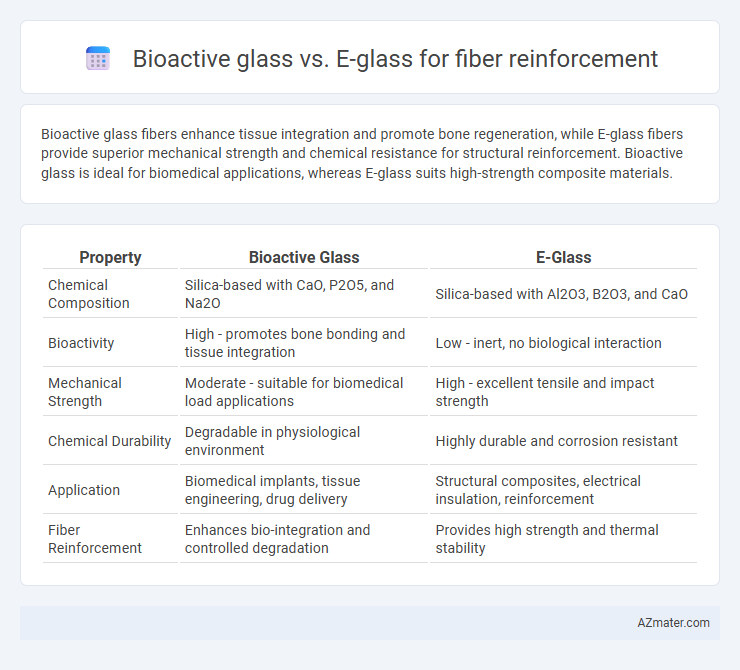Bioactive glass fibers enhance tissue integration and promote bone regeneration, while E-glass fibers provide superior mechanical strength and chemical resistance for structural reinforcement. Bioactive glass is ideal for biomedical applications, whereas E-glass suits high-strength composite materials.
Table of Comparison
| Property | Bioactive Glass | E-Glass |
|---|---|---|
| Chemical Composition | Silica-based with CaO, P2O5, and Na2O | Silica-based with Al2O3, B2O3, and CaO |
| Bioactivity | High - promotes bone bonding and tissue integration | Low - inert, no biological interaction |
| Mechanical Strength | Moderate - suitable for biomedical load applications | High - excellent tensile and impact strength |
| Chemical Durability | Degradable in physiological environment | Highly durable and corrosion resistant |
| Application | Biomedical implants, tissue engineering, drug delivery | Structural composites, electrical insulation, reinforcement |
| Fiber Reinforcement | Enhances bio-integration and controlled degradation | Provides high strength and thermal stability |
Introduction to Fiber Reinforcement in Composites
Bioactive glass and E-glass are prominent materials used in fiber reinforcement to enhance composite properties such as strength, durability, and biocompatibility. E-glass fibers are widely employed due to their excellent mechanical properties and cost-effectiveness, making them ideal for structural applications, while bioactive glass fibers offer unique advantages in biomedical composites by promoting tissue bonding and controlled bioactivity. The choice between bioactive glass and E-glass fibers depends on the specific application requirements, balancing mechanical performance with biological interaction in composite materials.
Overview of Bioactive Glass and E-Glass Fibers
Bioactive glass fibers possess unique biocompatibility and bone-bonding capabilities due to their silica-based composition enriched with calcium and phosphorus ions, promoting tissue regeneration and integration. E-glass fibers, predominantly composed of alumino-borosilicate glass, offer high tensile strength, electrical insulation, and chemical resistance, making them ideal for structural reinforcement in composites. The distinct chemical compositions and bioactivity profiles of bioactive glass and E-glass fibers result in tailored applications in biomedical implants and structural materials respectively.
Composition and Structural Differences
Bioactive glass fibers consist primarily of silica (SiO2), calcium oxide (CaO), sodium oxide (Na2O), and phosphorus pentoxide (P2O5), designed to bond with bone and promote bioactivity, while E-glass fibers are predominantly composed of silica (SiO2), alumina (Al2O3), calcium oxide (CaO), and boron oxide (B2O3), optimized for high tensile strength and electrical insulation. Structurally, bioactive glass fibers have a more amorphous phase with reactive surface sites facilitating hydroxyapatite formation, whereas E-glass fibers exhibit a more stable, crystalline structure with higher chemical durability and mechanical robustness. The compositional differences influence applications, with bioactive glass favored in biomedical implants for tissue integration and E-glass used in composites for structural reinforcement due to its superior mechanical and thermal properties.
Mechanical Properties Comparison
Bioactive glass fibers exhibit superior bioactivity and promote bone bonding but generally have lower tensile strength and fracture toughness compared to E-glass fibers. E-glass fibers demonstrate higher mechanical performance with tensile strengths typically ranging from 2.5 to 3.5 GPa and enhanced stiffness, making them more suitable for load-bearing structural reinforcement. However, the brittleness of bioactive glass can be mitigated by composite design, balancing mechanical durability with the benefits of bioactivity in biomedical applications.
Bioactivity and Biocompatibility
Bioactive glass fibers exhibit superior bioactivity compared to E-glass, promoting hydroxyapatite layer formation that enhances bone bonding and regeneration. Their intrinsic biocompatibility facilitates cellular proliferation and minimizes inflammatory responses, making them ideal for biomedical applications. In contrast, E-glass fibers primarily offer mechanical strength and corrosion resistance but lack significant biointeractive properties essential for tissue integration.
Degradation and Long-Term Stability
Bioactive glass fibers exhibit controlled degradation rates that promote bonding with bone tissue, making them ideal for applications requiring gradual resorption and bioactivity. E-glass fibers demonstrate superior long-term stability with minimal degradation under physiological conditions, maintaining mechanical integrity in structural composites. The choice between bioactive glass and E-glass fibers depends on the desired balance between bioresorbability and durability in fiber reinforcement applications.
Applications in Biomedical Materials
Bioactive glass offers superior bone bonding and osteoconductivity, making it ideal for orthopedic implants and tissue engineering scaffolds, whereas E-glass fibers provide high mechanical strength and chemical resistance, widely used in structural biomedical devices such as prosthetics and surgical instruments. The bioactivity of bioactive glass enhances cellular response and accelerates tissue regeneration, while E-glass maintains structural integrity under physiological conditions. Combining both materials can optimize performance in composite biomedical implants requiring both bioactivity and mechanical durability.
Processing and Fabrication Techniques
Bioactive glass fibers require precise sol-gel or melt-drawing techniques to retain their bioactivity and achieve suitable fiber diameters, often involving controlled cooling rates to prevent crystallization. In contrast, E-glass fibers are predominantly produced through continuous melting and fiberizing methods like flame attenuation, allowing mass production with consistent mechanical properties. Processing bioactive glass fibers demands careful control of thermal history and chemistry to maintain their biological performance, whereas E-glass fabrication prioritizes scalability and uniformity for reinforcement applications.
Cost Considerations and Commercial Availability
Bioactive glass fibers typically incur higher costs than E-glass fibers due to their specialized manufacturing processes and more limited production scale. E-glass fibers benefit from widespread commercial availability and well-established supply chains, resulting in lower prices and easier procurement for large-scale fiber reinforcement projects. Cost efficiency and extensive market presence make E-glass the preferred choice in applications where budget and availability are critical constraints.
Future Trends in Fiber Reinforced Composites
Bioactive glass fiber reinforcement offers enhanced biocompatibility and osteoconductivity, making it ideal for biomedical applications, while E-glass fibers provide superior mechanical strength and cost-effectiveness for structural composites. Future trends in fiber reinforced composites emphasize hybrid systems combining bioactive glass with E-glass to achieve optimized performance, integrating smart functionalities such as self-healing and bio-sensing. Advances in nanotechnology and additive manufacturing are expected to drive the development of multifunctional composites with tailored properties for aerospace, medical, and automotive industries.

Infographic: Bioactive glass vs E-glass for Fiber reinforcement
 azmater.com
azmater.com